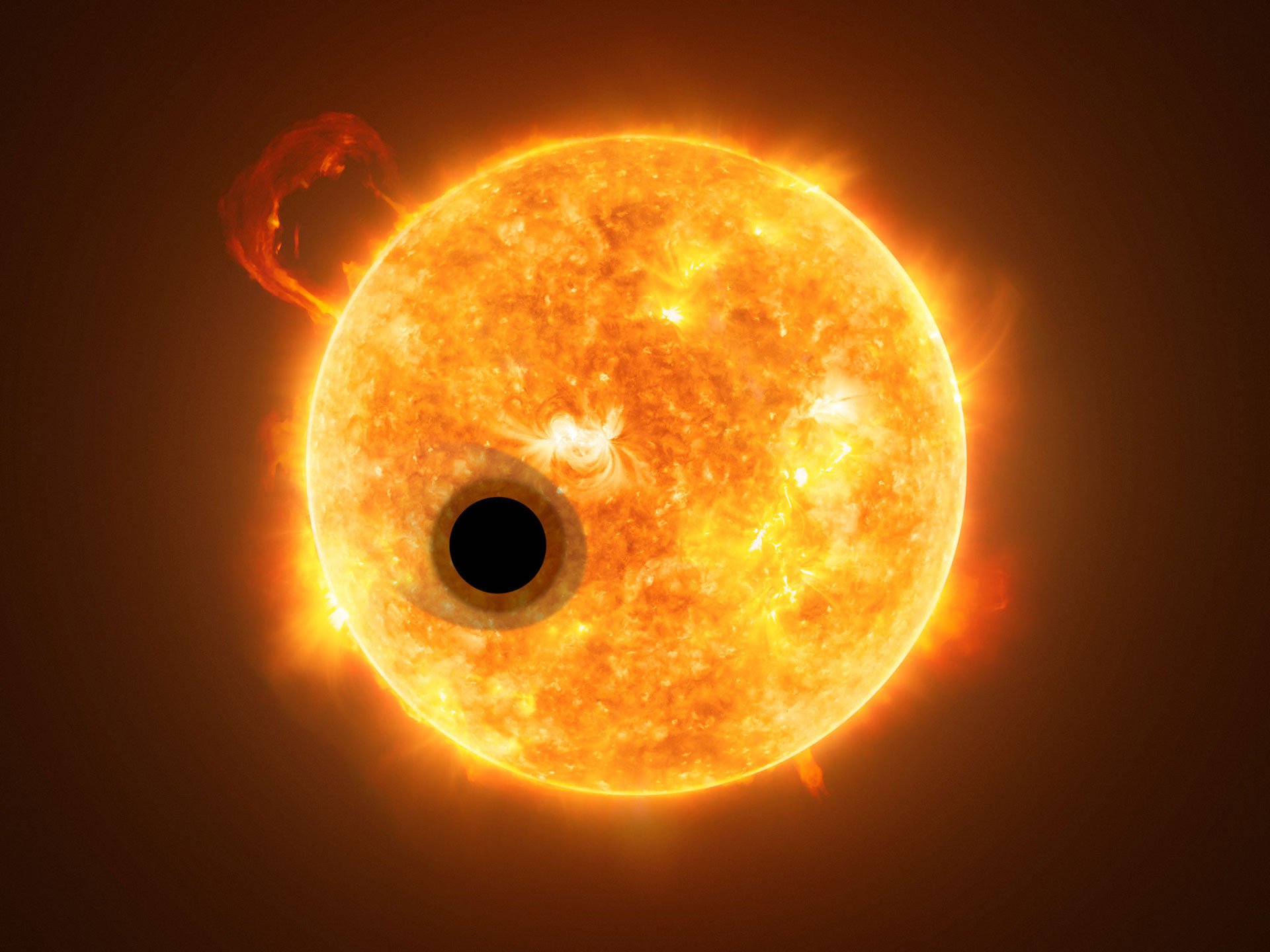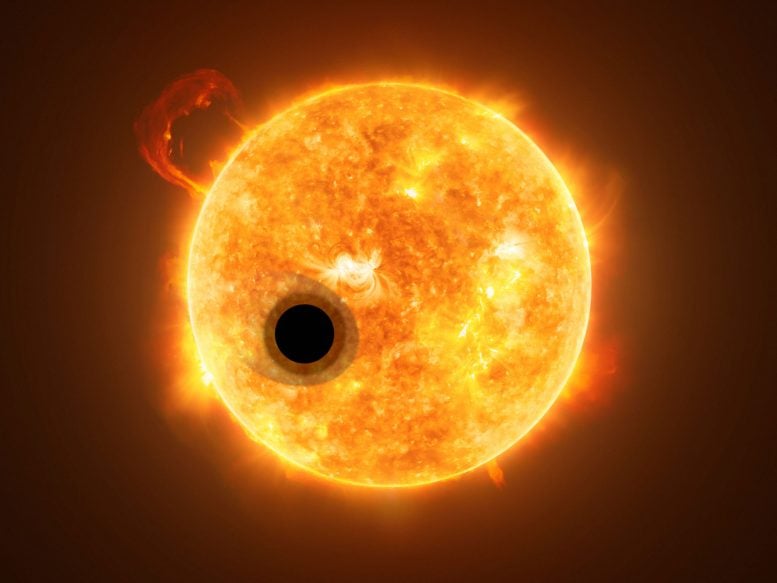
[ad_1]

Artistic representation of the exoplanet WASP-107b and its star, WASP-107. Some of the star’s light passes through the exoplanet’s extensive gas layer. ESA / Hubble, NASA, M. Kornmesser
The central mass of the giant exoplanet WASP-107b is much lower than what was deemed necessary to build the immense envelope of gas surrounding giant planets like Jupiter and Saturn, astronomers at Université de Montréal have found.
This intriguing discovery by Ph.D. student Caroline Piaulet at the UdeM’s Institute for Research on Exoplanets (iREx) suggests that gas giant planets form much more easily than previously believed.
Piaulet is part of the revolutionary research team of UdeM professor of astrophysics Björn Benneke who announced in 2019 the first detection of water on an exoplanet located in the habitable zone of its star.
Posted today (January 18, 2021) in the Astronomical journal along with colleagues in Canada, the United States, Germany and Japan, the new analysis of the internal structure of WASP-107b “has big implications,” Benneke said.
“This work addresses the very foundations of the formation and growth of giant planets,” he said. “This provides concrete proof that massive accretion of a gas shell can be triggered for nuclei that are much less massive than previously thought.”
As big as Jupiter but 10 times lighter
WASP-107b was first detected in 2017 around WASP-107, a star about 212 light years from Earth in the constellation Virgo. The planet is very close to its star – more than 16 times closer than Earth is to the Sun. As big as Jupiter but 10 times lighter, WASP-107b is one of the least dense exoplanets known – a type that astrophysicists have dubbed “super puff” or “cotton candy” planets.
Piaulet and his team first used observations of WASP-107b obtained at the Keck Observatory in Hawai’i to estimate its mass more accurately. They used the radial velocity method, which allows scientists to determine the mass of a planet by observing the oscillating motion of its host star due to the planet’s gravitational pull. They concluded that the mass of WASP-107b is about a tenth that of Jupiter, or about 30 times that of Earth.
The team then performed an analysis to determine the most likely internal structure of the planet. They came to a surprising conclusion: with such a low density, the planet must have a solid core no more than four times the mass of the Earth. This means that more than 85% of its mass is included in the thick layer of gas that surrounds this core. By comparing, Neptune, which has a mass similar to WASP-107b, has only 5 to 15 percent of its total mass in its gas layer.
“We’ve had a lot of questions about WASP-107b,” Piaulet said. “How could such a low density planet form? And how did he keep his huge layer of gas from escaping, especially given the planet’s proximity to its star?
“This motivated us to do a thorough analysis to determine its training history.”
A gas giant in the making
Planets form in the disk of dust and gas that surrounds a young star called the protoplanetary disk. Classic models for the formation of gas giant planets are based on Jupiter and Saturn. In these, a solid core at least 10 times more massive than the Earth is needed to accumulate a large amount of gas before the disk dissipates.
Without a massive nucleus, the gas giant planets were not supposed to cross the critical threshold necessary to build and maintain their large gas envelopes.
How then to explain the existence of WASP-107b, which has a much less massive core? McGill University professor and iREx member Eve Lee, a world-renowned expert on super-puff planets like WASP-107b, has several hypotheses.
“For WASP-107b, the most plausible scenario is that the planet has formed far from the star, where the gas in the disk is cold enough that gas accretion can occur very quickly,” he said. she declared. “The planet was then able to migrate to its current position, either through interactions with the disk or with other planets in the system.”
Discovery of a second planet, WASP-107c
Keck’s observations of the WASP-107 system cover a much longer period of time than previous studies, allowing the UdeM-led research team to make an additional discovery: the existence of a second planet, WASP-107c , with a mass about a third of that of Jupiter, much more than that of WASP-107b.
WASP-107c is also much further from the central star; it takes three years to complete an orbit around it, compared to only 5.7 days for WASP-107b. Also interesting: the eccentricity of this second planet is high, which means that its trajectory around its star is more oval than circular.
“WASP-107c has in some ways kept the memory of what happened in its system,” Piaulet said. “Its great eccentricity hints at a rather chaotic past, with interactions between the planets that could have led to important displacements, like that suspected for WASP-107b.”
Several other questions
Beyond its training history, there are still many mysteries surrounding WASP-107b. Studies of the planet’s atmosphere with the The Hubble Space Telescope published in 2018 revealed a surprise: it contains very little methane.
“It’s strange, because for this type of planet methane should be plentiful,” Piaulet said. “We are now reanalyzing the Hubble observations with the new mass of the planet to see how this will affect the results and to examine what mechanisms might account for the destruction of methane.
Young researcher plans to continue studying WASP-107b, hopefully James Webb Space Telescope scheduled for launch in 2021, which will give a much more precise idea of the composition of the planet’s atmosphere.
“Exoplanets like WASP-107b that have no analogue in our solar system allow us to better understand the mechanisms of planetary formation in general and the resulting variety of exoplanets,” she says. “It motivates us to study them in detail.”
Reference: “The Density of WASP-107b Is Even Lower: A Case Study for the Physics of Gas-Envelope Accretion and Orbital Migration” by Caroline Piaulet, Björn Benneke, Ryan A. Rubenzahl, Andrew W. Howard, Eve J. Lee, Daniel Thorngren, Ruth Angus, Merrin Peterson, Joshua E. Schlieder, Michael Werner, Laura Kreidberg, Tareq Jaouni, Ian JM Crossfield, David R. Ciardi, Erik A. Petigura, John Livingston, Courtney D. Dressing, Benjamin J. Fulton, Charles Beichman, Jessie L. Christiansen, Varoujan Gorjian, Kevin K. Hardegree-Ullman, Jessica Krick and Evan Sinukoff, January 18, 2021, Astronomical journal.
DOI: 10.3847 / 1538-3881 / abcd3c
Besides Piaulet (iREx doctoral student, Université de Montréal) and professors Björn Benneke (iREx, Université de Montréal) and Eve Lee (iREx, McGill Space Institute, McGill University), the research team includes Daniel Thorngren (postdoctoral iREx Fellow , Université de Montréal) and Merrin Peterson (iREx M.Sc student), and 19 other co-authors from Canada, the United States, Germany and Japan.
[ad_2]
Source link